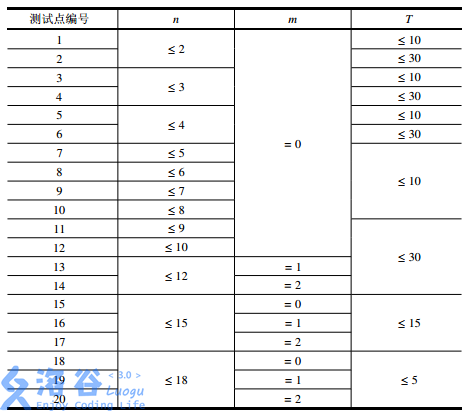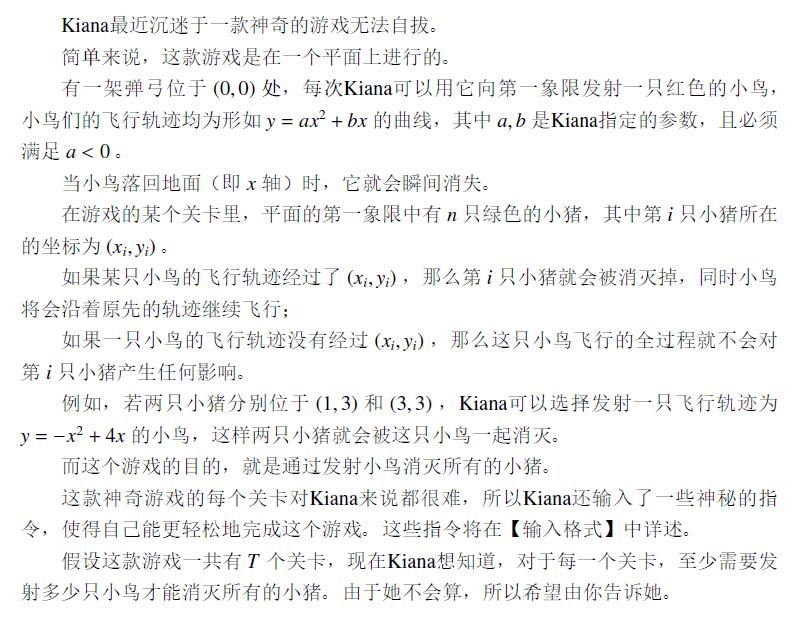[NOIP2016]憤怒的小鳥(狀壓DP)
[NOIP2016]憤怒的小鳥(狀壓DP)
題目描述
輸入輸出格式
輸入格式:
第一行包含一個正整數 T,表示遊戲的關卡總數。
下面依次輸入這 T個關卡的資訊。每個關卡第一行包含兩個非負整數 n,m,分別表示該關卡中的小豬數量和 Kiana 輸入的神祕指令型別。接下來的 n行中,第 ii 行包含兩個正實數,表示第 i只小豬座標為
。資料保證同一個關卡中不存在兩隻座標完全相同的小豬。
如果 m=0,表示Kiana輸入了一個沒有任何作用的指令。
如果 m=1,則這個關卡將會滿足:至多用
如果 m=2,則這個關卡將會滿足:一定存在一種最優解,其中有一隻小鳥消滅了至少只小豬。
保證
輸出格式:
對每個關卡依次輸出一行答案。
輸出的每一行包含一個正整數,表示相應的關卡中,消滅所有小豬最少需要的小鳥數量。
輸入輸出樣例
輸入樣例#1:
2 2 0 1.00 3.00 3.00 3.00 5 2 1.00 5.00 2.00 8.00 3.00 9.00 4.00 8.00 5.00 5.00
輸出樣例#1:
1 1
輸入樣例#2:
3 2 0 1.41 2.00 1.73 3.00 3 0 1.11 1.41 2.34 1.79 2.98 1.49 5 0 2.72 2.72 2.72 3.14 3.14 2.72 3.14 3.14 5.00 5.00
輸出樣例#2:
2 2 3
輸入樣例#3: 複製
1 10 0 7.16 6.28 2.02 0.38 8.33 7.78 7.68 2.09 7.46 7.86 5.77 7.44 8.24 6.72 4.42 5.11 5.42 7.79 8.15 4.99
輸出樣例#3:
6
說明
【樣例解釋1】
這組資料中一共有兩個關卡。
第一個關卡與【問題描述】中的情形相同,22只小豬分別位於(1.00,3.00)(1.00,3.00)和 (3.00,3.00)(3.00,3.00),只需發射一隻飛行軌跡為y = -x^2 + 4xy=−x2+4x的小鳥即可消滅它們。
第二個關卡中有55只小豬,但經過觀察我們可以發現它們的座標都在拋物線 y = -x^2 + 6xy=−x2+6x上,故Kiana只需要發射一隻小鳥即可消滅所有小豬。
【資料範圍】

Solution
(我們知道三點確定一個拋物線,此處的n<=18)
列舉兩頭豬,設座標為,以
作拋物線,求出拋物線上有哪些豬,記為:
於是
這顯然是一個的做法,似乎不太優秀。
事實上,這個DP有可優化之處:每一次列舉的拋物線必須包含未消滅的第一頭豬!
Because列舉的拋物線的順序與最優解無關,並且未消滅的豬在之後的拋物線中必須被覆蓋到至少一次,那麼與其先覆蓋其他的豬,不如直接先覆蓋第一頭未消滅的豬,這對答案是沒有影響的。因此,每一次轉移只需要列舉能覆蓋第一頭未消滅的豬的拋物線即可。
改變了轉移之後,時間複雜度變為,輕鬆AC。
#include <vector>
#include <list>
#include <map>
#include <set>
#include <deque>
#include <queue>
#include <stack>
#include <bitset>
#include <algorithm>
#include <functional>
#include <numeric>
#include <utility>
#include <sstream>
#include <iostream>
#include <iomanip>
#include <cstdio>
#include <cmath>
#include <cstdlib>
#include <cctype>
#include <string>
#include <cstring>
#include <ctime>
#include <cassert>
#include <string.h>
//#include <unordered_set>
//#include <unordered_map>
#define MP(A,B) make_pair(A,B)
#define PB(A) push_back(A)
#define SIZE(A) ((int)A.size())
#define LEN(A) ((int)A.length())
#define FOR(i,a,b) for(int i=(a);i<(b);++i)
#define fi first
#define se second
using namespace std;
template<typename T>inline bool upmin(T &x,T y) { return y<x?x=y,1:0; }
template<typename T>inline bool upmax(T &x,T y) { return x<y?x=y,1:0; }
typedef long long ll;
typedef unsigned long long ull;
typedef long double lod;
typedef pair<int,int> PR;
typedef vector<int> VI;
const lod eps=1e-6;
const lod pi=acos(-1);
const int oo=1<<30;
const ll loo=1ll<<62;
const int mods=1e9+7;
const int MAXN=20;
const int INF=0x3f3f3f3f;//1061109567
/*--------------------------------------------------------------------*/
inline int read()
{
int w=0; bool q=1; char c=getchar();
while ((c<'0'||c>'9')&&c!='-') c=getchar();
if (c=='-') q=0,c=getchar();
while (c>='0'&&c<='9') w=w*10+c-'0',c=getchar();
return q?w:-w;
}
int g[MAXN][MAXN],s[MAXN],f[(1<<MAXN)+5];
double x[MAXN],y[MAXN];
inline bool check(double x,double y){ return abs(x-y)<eps; }
int main(){
s[0]=1;
for (int i=1;i<=19;i++) s[i]=s[i-1]<<1;
int Case=read();
while (Case--){
int n=read(),m=read();
for (int i=1;i<=n;i++) scanf("%lf%lf",&x[i],&y[i]);
memset(g,0,sizeof(g));
memset(f,INF,sizeof(f)); f[0]=0;
for (int i=1;i<=n;i++)
for (int j=i+1;j<=n;j++) {
if (check(x[i],x[j])) continue; double a=(y[j]/x[j]-y[i]/x[i])/(x[j]-x[i]);
if (a>=0) continue; double b=y[i]/x[i]-a*x[i];
for (int k=1;k<=n;k++) g[i][j]+=s[k-1]*(check(a*x[k]+b,y[k]/x[k]));
}
for (int i=0;i<=s[n]-1;i++)
for (int j=1;j<=n;j++)
if (!(i&s[j-1])){
for (int k=j+1;k<=n;k++) upmin(f[i|g[j][k]],f[i]+1);
upmin(f[i|s[j-1]],f[i]+1);
}
printf("%d\n",f[s[n]-1]);
}
return 0;
}

